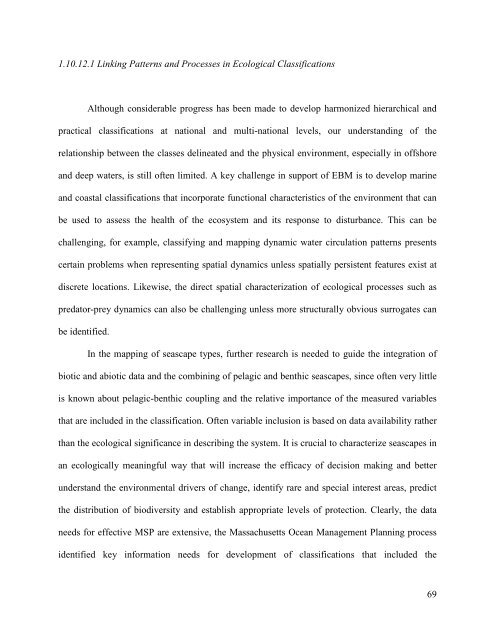1 1.10 Application of estuarine and coastal classifications in marine ...
1 1.10 Application of estuarine and coastal classifications in marine ...
1 1.10 Application of estuarine and coastal classifications in marine ...
You also want an ePaper? Increase the reach of your titles
YUMPU automatically turns print PDFs into web optimized ePapers that Google loves.
<strong>1.10</strong>.12.1 L<strong>in</strong>k<strong>in</strong>g Patterns <strong>and</strong> Processes <strong>in</strong> Ecological Classifications<br />
Although considerable progress has been made to develop harmonized hierarchical <strong>and</strong><br />
practical <strong>classifications</strong> at national <strong>and</strong> multi-national levels, our underst<strong>and</strong><strong>in</strong>g <strong>of</strong> the<br />
relationship between the classes del<strong>in</strong>eated <strong>and</strong> the physical environment, especially <strong>in</strong> <strong>of</strong>fshore<br />
<strong>and</strong> deep waters, is still <strong>of</strong>ten limited. A key challenge <strong>in</strong> support <strong>of</strong> EBM is to develop mar<strong>in</strong>e<br />
<strong>and</strong> <strong>coastal</strong> <strong>classifications</strong> that <strong>in</strong>corporate functional characteristics <strong>of</strong> the environment that can<br />
be used to assess the health <strong>of</strong> the ecosystem <strong>and</strong> its response to disturbance. This can be<br />
challeng<strong>in</strong>g, for example, classify<strong>in</strong>g <strong>and</strong> mapp<strong>in</strong>g dynamic water circulation patterns presents<br />
certa<strong>in</strong> problems when represent<strong>in</strong>g spatial dynamics unless spatially persistent features exist at<br />
discrete locations. Likewise, the direct spatial characterization <strong>of</strong> ecological processes such as<br />
predator-prey dynamics can also be challeng<strong>in</strong>g unless more structurally obvious surrogates can<br />
be identified.<br />
In the mapp<strong>in</strong>g <strong>of</strong> seascape types, further research is needed to guide the <strong>in</strong>tegration <strong>of</strong><br />
biotic <strong>and</strong> abiotic data <strong>and</strong> the comb<strong>in</strong><strong>in</strong>g <strong>of</strong> pelagic <strong>and</strong> benthic seascapes, s<strong>in</strong>ce <strong>of</strong>ten very little<br />
is known about pelagic-benthic coupl<strong>in</strong>g <strong>and</strong> the relative importance <strong>of</strong> the measured variables<br />
that are <strong>in</strong>cluded <strong>in</strong> the classification. Often variable <strong>in</strong>clusion is based on data availability rather<br />
than the ecological significance <strong>in</strong> describ<strong>in</strong>g the system. It is crucial to characterize seascapes <strong>in</strong><br />
an ecologically mean<strong>in</strong>gful way that will <strong>in</strong>crease the efficacy <strong>of</strong> decision mak<strong>in</strong>g <strong>and</strong> better<br />
underst<strong>and</strong> the environmental drivers <strong>of</strong> change, identify rare <strong>and</strong> special <strong>in</strong>terest areas, predict<br />
the distribution <strong>of</strong> biodiversity <strong>and</strong> establish appropriate levels <strong>of</strong> protection. Clearly, the data<br />
needs for effective MSP are extensive, the Massachusetts Ocean Management Plann<strong>in</strong>g process<br />
identified key <strong>in</strong>formation needs for development <strong>of</strong> <strong>classifications</strong> that <strong>in</strong>cluded the<br />
69
















